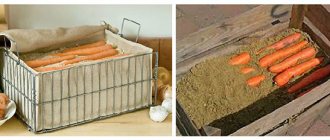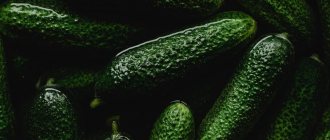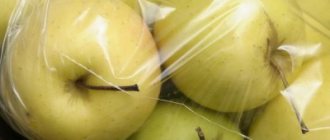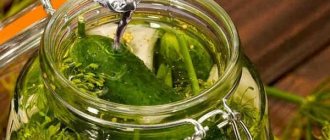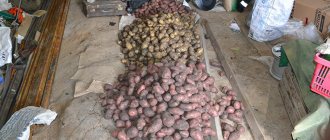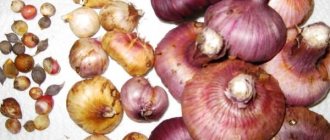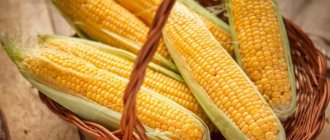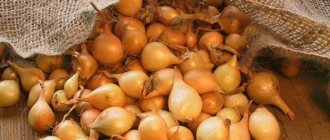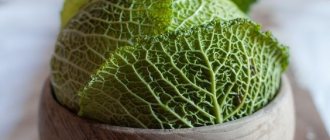Despite the fact that pumpkin is a healthy and tasty product, you can rarely find it in stores in winter. Therefore, the issue of storing melons grown by yourself or purchased on the market becomes relevant every autumn. The optimal place to store pumpkins is a dark, cool cellar that maintains average air humidity. In such conditions, the fruits lie quietly and remain fresh all winter. Thus, winter storage of pumpkins in the cellar has several features. Let's look at them in more detail.
Is it possible to store pumpkin in the cellar?
Pumpkin is a universal product used for preparing first and second courses and desserts. The harvest collected from your own garden is especially tasty and healthy. But is it possible to preserve the fruits for a long time?
For this purpose, choose dry, cool and dark rooms. Owners of private houses use a cellar for storage; residents of megacities have to be content with balconies and basements.
Points for and against"
It’s good if the gardener has a cellar for storing vegetables. However, having a suitable room does not mean that you can put away the harvest and forget about it for a long time. Storage rules must be followed.
Despite the fact that pumpkin vegetables can be stored until spring, under unfavorable conditions they quickly deteriorate. To enjoy fresh vegetables in winter, you will need to work hard to prepare the room.
In addition to the cost of processing and disinfection, it is necessary to make good ventilation, and also take care of purchasing racks and shelves.
Pumpkin storage
Pumpkin preparations
Even with proper storage, a cut pumpkin may lose its beneficial qualities, vitamins, and the taste will become worse. If you didn’t manage to eat the vegetable right away, then you can make preparations for the winter, and in winter eat delicious dishes from this product.
Pickling
This method requires a vegetable with dense, but not hard, pulp. Marinating should be accompanied by:
- cutting pumpkin into small pieces;
- three-minute blanching, cooling;
- decomposition into glass jars and pouring marinade.
To prepare the latter you will need:
- sugar – 1 tbsp;
- salt – 1 tsp;
- cloves – 5 pcs.;
- allspice peas – 6 pcs.;
- cinnamon – 1 p.;
- water – 1 l;
- vinegar 9% - 100 ml.
Attention!
You can use your favorite spices.
Mix all ingredients except vinegar and bring to a boil. Reduce heat and simmer for another five minutes. Pour in vinegar and mix thoroughly. Pour the resulting marinade over the pumpkin and seal tightly.
Pumpkin puree
This dish is chosen for its delicate and rich taste, low calorie content and low sugar content. This snack will appeal to those who are watching their figure or following a diet for other reasons.
To prepare the puree you need 1 kg of pumpkin and 0.5 kg of apricots. Wash the ingredients and remove the seeds and seeds. Grind with a blender, add 1.5 tbsp. Sahara. Cook over low heat for two hours, stirring constantly. At the end of cooking, add 1 tsp. citric acid and mix the puree well.
Candied pumpkin
You can prepare candied pumpkin for the winter. It won't take much time.
First you need to boil the sugar syrup. For it, mix 200 ml of water, 1-1.5 kg of granulated sugar and a pinch of vanilla and citric acid. Cook over low heat until smooth and sugar is completely dissolved. Then you will need:
- cut the pumpkin into large pieces, put it in syrup and boil. Cool. Repeat the procedure three times.
- leave for 5-7 hours, then bring to a boil again and cool;
- Place the prepared candied fruits in a sieve to cool.
They are stored for about six months. It is better to use an airtight glass container lined with parchment for this.
Pumpkin seeds
You can prepare not only fruits, but also seeds for the winter. Dried seeds are an unusual delicacy and addition to baked goods. This became possible thanks to the unusual taste and aroma.
To prepare you need:
- separate the seeds from the pulp;
- place them on a baking sheet and leave them for a day in a room with good ventilation;
- bake in the oven for 2 hours at 40-50 degrees.
You can determine the readiness of the seeds by their color: they should brown a little.
Pumpkin powder
Those who like to drink pumpkin juice always leave a lot of pulp behind. The waste resulting from preparing the drink should not be thrown away - it is suitable for creating a special powder used as an additive when baking desserts.
To do this, you will need to cover a baking sheet with parchment, foil, and put the pulp out of the juicer. Place in the oven at 135℃.
Attention!
It is important to stir the product so that it does not burn. This should be done every 2 hours.
Once the pulp is cooked, grind it to a powder. Store it in jars or bags.
Dried pumpkin
You can replace unhealthy chips with dried pumpkin pieces. They are stored for several months. For preparation you will need:
- cut the fruit into cubes measuring 5x5 cm, each of which is also cut into slices 3 mm thick;
- Blanch them for three minutes and then place them on a tray.
An oven or electric dryer is suitable for drying. It will take about 6 hours to prepare.
Pumpkin caviar with vegetables
Fans of vegetable dishes will enjoy this preparation. This is a mix of pumpkin, onions, carrots, seasoned with spices. Can be stored all winter. Ika can be used as an independent dish, an additive to meat or a paste for sandwiches.
How to cook:
- prepare 1 kg of pumpkin, 0.5 kg of carrots and 2 large onions. Clean the ingredients;
- grate carrots, chop onions and sauté them with the addition of spices;
- Boil the pumpkin until soft and mix with vegetables. Grind with a blender until smooth.
If you want, you can use other vegetables.
Optimal storage conditions
Most basements are suitable for long-term storage of crops. Violation of temperature indicators leads to loss of taste, freezing and spoilage of the pumpkin.
Requirements for the cellar
Optimal conditions for storing pumpkins are air temperature +5°C (+10°C for some varieties) and humidity - 70-75%. Keep in mind that the indicators differ at different heights relative to the floor: the lower, the colder. It is recommended to take temperature measurements at the lower level.
If the temperature there is 0...+2°C, the crop is transferred to shelves or racks.
In severe frosts, the pumpkin may freeze. In winter, it is necessary to monitor changes in temperature in the cellar. As soon as the mark drops below 0°C, the fruits are wrapped in straw, old fur coats or blankets.
Preparing the premises
Melon crops lie well in the basement in winter and spring. Before harvesting from the field, the room must be prepared for it. The main enemy of vegetables is mold, so the walls of the basement, as well as its floor and ceiling, will need to be cleaned of white deposits. Since in cool cellars where food is stored, in addition to fungi, there are various bacteria, you will need to disinfect all surfaces with a solution of iron sulfate or lime and it is better to do this 3-4 weeks before storing vegetables.
Smoke (sulfur) bombs are used to disinfect the premises. With their help, it will be possible to quickly destroy mold and harmful microorganisms in the cellar, and get rid of pests (woodlice, woodworms, mice). But if there are jars of last year’s preserves left in the room, before using the checkers, they are taken out of the basement, since harmful compounds can penetrate inside the containers. Before storing the crop in the cellar, you should ventilate the room for several days so that no dangerous sulfur vapor remains in it.
Dust and sand must be swept away from all shelves and racks, surfaces must be washed and thoroughly dried. It is better to do this work on hot summer days. Then it is necessary to ventilate the basements so that there is no musty smell in them, and also dry them from dampness.
Pumpkin storage in the cellar is carried out on clean and dry surfaces, covered with straw or hay, paper. To protect the room from moisture, a box filled with ash or sawdust may be provided. It is better to place 1 or 2 boxes in close proximity to the harvested crop.
Suitable varieties
Not all pumpkin varieties are suitable for long-term storage. Late-ripening fruits with strong skin and rich orange pulp will safely overwinter in the cellar.
Among these varieties:
- Vitamin;
- Zhdana;
- Pearl;
- Arbatskaya;
- Nutmeg;
- Gymnosperm;
- Interception;
- Vita;
- Butternut;
- Testi Delipe.
Which varieties are suitable for storage?
Not all varieties of vegetables that gardeners grow on their plots are shelf-stable. For this reason, before purchasing seed material, this aspect must be clarified with the seller. It is better to sow seeds of mid- and late-ripening pumpkin varieties. This is important if the product will be stored in a basement or cellar.
Varieties with long shelf life include:
- Kherson - this plant is drought-resistant and heat-loving. The vegetable has a slightly flattened shape, the peel is gray and dense.
- Slavuta is a sweet species with a late ripening period. The skin is greyish-green.
- Yanina is a mid-season oval variety. The peel is orange and the taste is sweet.
- Gileyu is a nutmeg pumpkin with a mid-season ripening period and a thin skin.
- Polyanina is a cylindrical mid-season pumpkin with a brown skin. Suitable for preparing baby food.
- Vitamin - a late-ripening variety with oval fruits, the ripening of which occurs in approximately 120 days. Sowing must be done in the summer, after warm days have established. The weight of one fruit is from 4 to 7 kg.
- Winter sweet - the weight of pumpkin can reach 12 kg.
- Pearl - shaped like a pear, the pulp is suitable for consumption even raw. The weight of one fruit is no more than 5 kg.
- Intercept - a late-ripening variety with the largest weight of 3 kg. Fruits can be elongated or shortened. If you often prepare casseroles or juice, then this is an ideal option.
- Zhdannu is a mid-season variety characterized by large pumpkins, up to 8 kg.
- Arabatskaya is a muscat species, the full ripening of which occurs in 118-128 days. Outwardly, it strongly resembles a zucchini. It will last well in the cellar, but the weight of one vegetable varies between 9-20 kg.
- Gymnosperm is a mid-early species, weighing 5-15 kg. They are distinguished by their hard skin and long shelf life if the right conditions are met.
Experts advise storing the listed vegetable varieties for the winter, because... They are large, juicy and do not spoil for a long time.
How to prepare pumpkin for storage in the cellar
For long-term storage, only whole, unspoiled fruits are selected. If dark spots or other damage appears on the pumpkin, it is better to process it immediately.
Important! Pumpkins with moldy areas must be disposed of - simply cutting off the damage is not enough.
When harvesting, it is important for gardeners to leave a 10 cm long stalk on the fruit. Such pumpkins last longer. The tail is not torn off with bare hands, but a knife is used. If the stalk has been cut off completely, this opens access inside for bacteria and infections. The tail should be green and undamaged.
Strong and fully ripened pumpkins are sent to the cellar. Fruits that are too small or large are not suitable for home storage - it is better to process them or freeze them.
The collected fruits are cleaned of dirt with a dry towel. If the harvest took place in rainy weather, the pumpkins are completely dried in a dry, dark place before storing.
Preparing the premises
Preparing the cellar for harvest storage is an important event, without which it is impossible to ensure the safety of vegetables until winter. Work on the improvement of the premises begins a month before harvesting the fruits.
Stages of room preparation:
- Get rid of dampness and mold . The cellar is ventilated, the racks and shelves are treated and dried, and a ventilation system is installed.
- Disinfect from infections and parasites. In the fall, before planting vegetables, the room is treated with a sulfur bomb or lime.
- Clear away debris. The entire last year's harvest is taken out of the cellar. Vegetables are thrown away or processed. Cans of preserved food are left on the shelves.
- Prepare the racks. The shelves are lined with several layers of paper or straw.
Admissible neighborhood
Not all vegetables can be stored with pumpkin. It easily absorbs odors, which spoils its taste. The fruits can be stored with zucchini, eggplant and radishes. It is better not to intersect pumpkin with other crops.
Important! Apples and pears are not the best neighbors for pumpkins. Fruits emit ethylene, which reduces the shelf life of the fruit.
If the room is small and you need to store several types of vegetables, the crops are placed at different height levels.
Saving periods
How long can pumpkins be stored in the cellar? The average for most pumpkins is six months , although it depends on the specific variety of vegetable. Table varieties are better long-lived, while forage varieties can only be stored for a few months . It is better not to exceed the permissible shelf life, even if the vegetable seems perfect in appearance, without rotten plaque or traces of infection.
Don't let pumpkins sit unattended in the cellar all season - inspect the produce occasionally and eat those that are starting to spoil. This is especially important during severe frosts .
Vegetables will need an additional layer of protection - you can insulate them by adding a little more dry straw and covering them with sheets of newspaper or thick cloth. The main thing is to give the pumpkins the opportunity to “breathe”, but not to accumulate excess condensation.
Methods for storing pumpkin
When stored properly, pumpkin remains fresh and does not lose its taste. Fruits with traces of rot or an unpleasant odor are not suitable for consumption.
To keep the pumpkin fresh, it is better to store it whole. However, in city conditions, most owners prefer to use space sparingly, so they cut it into pieces.
Whole fruits
In order for the pumpkin to survive until spring, you need to arrange it correctly:
- Fruits are not stored on bare shelves - the racks are covered with straw or paper.
- The pumpkin should not touch the walls of the room. Due to temperature changes, condensation and mold form on them.
- The fruits are placed with the stalks facing up. You can see from the tail that the vegetable has begun to deteriorate.
- The pumpkin should not come into contact with its “neighbors”. If one fruit rots, the entire harvest will be spoiled.
- Vegetables should not be stored in a pyramid or piled on the floor.
- Check the stock status once a month or more often.
Regular visits to the cellar will allow you to notice problems in time. If condensation begins to form on the fruits, this is a sign of increased air humidity. The situation requires immediate action, otherwise the plaque will eventually turn into dark spots and the harvest will be spoiled.
To reduce humidity, the room is regularly ventilated. You can also put a bucket of quicklime in the cellar - it absorbs moisture well.
If there are no shelving in the cellar, the pumpkin is stored in boxes or boxes. It is important to fill the spaces between the vegetables with straw or newspaper so that their sides do not touch.
Cut into pieces
To save space, cut the pumpkin into pieces, freeze and place in the refrigerator. If stored properly, it will remain fresh for a year.
How to prepare pumpkin for freezing :
- Wash the vegetable and peel it.
- Remove pumpkin seeds.
- Cut into pieces.
- Place in portions into containers or plastic bags.
- Place the workpiece in the freezer.
Peculiarity. Frozen pumpkin is used to prepare various dishes, with the exception of juice.
Variety selection and preparation
What varieties of pumpkin are best suited for storage in the cellar and basement?
Late-ripening fruits are designed for longer storage, which can be distinguished by their strong peel, deep orange hue and tender, appetizing pulp.
Good muscat varieties can last for about six months in an optimal environment. Typical representatives: “Vitaminnaya”, “Pearl”, “Intercept”, “Vita”, “Muscatnaya”, “Butternut Ponka”, “Testy Delipe”.
Among mid-season varieties, varieties with excellent keeping quality , for example “Zhdanna”, “Golosemyannaya” and “Arabatskaya”. These large fruits have a hard bark and are highly resistant to disease.
If you are going to store a purchased pumpkin in the cellar, then pay attention to the stalk : a completely cut off tail will pose a threat to the entire fruit. It will become a kind of entrance for harmful microbes, allowing various diseases to develop inside. Never cut off the stem at the root - leave about 8-12 cm . Do not try to tear off the tail with your bare hands, only with a knife.
How to prepare a pumpkin for storage in the cellar? First of all, you will have to select the most successful fruits. Sort ripe pumpkins from unripe ones , and healthy ones from those affected by diseases.
Simply cutting off areas with dark spots and mold is not enough : this will only increase the risk of mold development, but will not protect healthy vegetables from infection. You should also store only whole pumpkins, without cracks, areas of the skin eaten away by pests, etc.
The crop that has just been harvested from the beds must be cleaned of dirt with a dry towel and left to dry in a dark, dry place.
Remember that the pumpkin must retain its natural protective layer . That is why, after harvesting, you should not wash or wipe the plants with a damp cloth - this will only serve the pathogens.
How to store pumpkin in the basement in winter? Pumpkins should not be piled up or piled up - try to arrange the vegetables so that they do not touch each other or the walls of the cellar . It is best to lay them out on shelves or wooden platforms, well covered with straw or parchment. This is necessary to avoid the accumulation of excess moisture on the skin of the pumpkins.
In addition to dry litter, from time to time (once a month) you will need to monitor the condition of the crop itself.
As soon as the first signs of infection are noticed, it is better to remove a large vegetable from the main mass and throw it away.
If the humidity is too high, gently wipe the vegetables with a dry towel and leave the area open for better ventilation .
In order not to wastefully throw away copies that are slightly damaged only on the side, areas with scratches or dents can be carefully cut off with a knife. However, after this it is advisable to store the pumpkin no longer in the cellar or basement, but in a refrigerator or freezer . You can learn how to freeze pumpkin in the freezer for later cooking in our article.
Tips and tricks
To preserve your harvest without loss, follow expert advice:
- To disinfect the cellar, in addition to lime, use copper sulfate and a 2% solution of table salt.
- After using sulfur bombs, the cellar is ventilated for at least 2 days.
- To absorb moisture, boxes with dry sawdust and ash are placed in the room.
- As soon as the paper backing becomes damp, it is replaced.
- You can protect fruits from freezing by covering them with thick fabric.
- A common mistake gardeners make is picking unripe fruits, which causes them to spoil.
- Pumpkin has a natural protective layer, which, due to inexperience, the gardener can wash off. Before storing the fruit, just wipe it with a dry cloth.
How to dry and preserve pumpkin
The dried fruit is also tasty. In addition, it also has beneficial properties. You can prepare it naturally or use kitchen appliances.
In the sun
Cut the fruit randomly and place it on a tray in one layer. Place on the windowsill so that the workpiece receives direct sunlight. It is acceptable to display it on the balcony or veranda.
Attention!
You can protect the workpiece from dirt, insects and birds by covering it with gauze.
In dry and warm weather, cooking will take 7-10 days.
In the oven
Cut the pumpkin into 10 mm slices and blanch. Lay out the workpiece in one layer, leaving some space between the slices.
Place the baking sheet in the oven. The door should be slightly open during cooking. The procedure lasts in two stages. The first involves drying the vegetable in the oven at 55-60℃ for five hours. After this, turn it over and cool.
Then raise the temperature to 75-80℃ and continue drying until done.
How to store?
Dried
Dried pumpkin
To make storing pumpkin easier, you can dry it. In this case, it will take up less space and will not deteriorate. For drying, you can use a conventional oven or a special electric dryer.
It is carried out in several stages:
- Wash the pumpkin skin, then scoop out the pulp and remove the seeds.
- Cut the pumpkin into small pieces about 1 cm thick.
- Line a baking sheet with parchment paper and spread the pumpkin slices on it in a thin layer.
- Preheat the oven to 60C and dry the pumpkin for 5 hours. Leave the oven on from time to time. The temperature should not rise above 80C. You won't have to do these steps if you use an electric oven that can maintain a constant temperature.
- Remove well-dried pieces and leave to cool.
- Store dried pumpkin in an airtight container.
In brine
Pumpkin in brine
This will preserve the pumpkin until spring and you can enjoy this wonderful vegetable all winter long. Pickled pumpkin can be prepared as follows:
- Wash the peel, then cut everything into slices and remove the seeds.
- Transfer the slices into sterilized jars.
- Prepare the brine - dissolve 3 tablespoons of salt in 1.5 liters of chilled boiled water.
- Pour the brine into the jars containing the pumpkin to the top of the container and cover with a plastic lid.
Store jars of pumpkin in the cellar or refrigerator.
In the marinade
Pumpkin in marinade
Pickled pumpkin resembles canned pineapple. This storage method will allow you to enjoy your favorite vegetable for a whole year or even more. It can be served as a side dish for meat dishes or as an independent dish.
For marinating you will need the following ingredients:
- pumpkin - 1 pc.
- water - 1.5 l
- citric acid - 1 tbsp. spoon with glass;
- sugar - 150 gr;
- salt - 1 tsp;
- lemongrass - 7 leaves;
- radiola pink - 7 g.
To prepare the marinade, you will also need a sterilized glass jar.
Pumpkin can be pickled as follows:
- Wash a medium-sized pumpkin, scoop out the pulp and remove the seeds. Cut the pulp into small cubes.
- Boil the pumpkin for about 5 minutes, then place the cooked pieces in a sterilized jar.
- Prepare the dressing by boiling water with sugar, salt, citric acid, lemongrass leaves and Rhodiola rosea powder.
- Pour the filling into the jar containing the pumpkin.
- Close the jar with a metal lid and turn it upside down for a while.
- Store pickled pumpkin in a cool place, preferably in a cellar.
